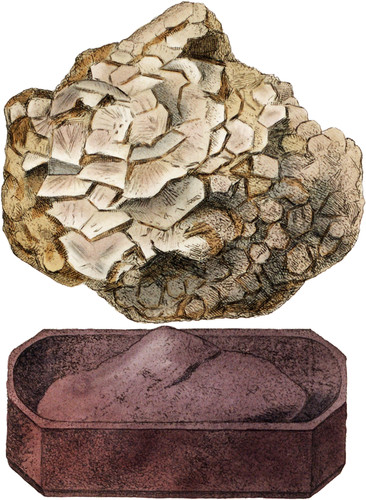 Enlarge
Enlarge
Exotic Mineralogy
Lepidolite
- Syn.
- Lepidolithe. Haüy, Traité 4. 375. Tabl. 64.
- Lepidolith. Emmerl. 3. 324. Werner.
- Lepidolite. Kirw. 1. 208.
- Lepidolide. Bourn. Catal. 111.
This substance, the more common variety of which much resembles Avanturin, must not, however, be confounded with it, as it may easily be known by its inferior hardness. The varieiy in large plates so nearly resembles Mica externally, that it is no wonder if it be mistaken for it, unless its flexibility be tried. It is tlierefore our business to show it as distinctly as possible. The Mica-like illinitions, if I may so call them, are only the shining faces of the laminæ of its crystals seen through the transparent sides; their being heaped together in a mass causes them to reflect the light in every direction. The upper figure is a fine, variety, displaying the crystals and showing the shining surfaces in large laminæ very like Mica, and indicates angles of rhoniboidal and hexaedral plates, nearly approaching to regularity, but nosic so perfectly defined as to determine the measure (which perhaps may prove an useful character). The Count de Bournon describes the primitive form to be a regular hexaëdral prism, whose terminal planes are perpendicular to the sides. It has no elasticity like Mica, and breaks in less regular plates and more splintery fragments. It is scarcely so hard as common crystallized Carbonate of Lime, being more easily scratched by a knife: its lustre is very considerable, and its transparency rather greater than that usual to Mica. It is more fusible than Mica, as the Count de Bournon observes with the following illustration. “Mica is, thouth difficultly fusible by the blow-pipe, and gives a more or less brown or black glass; but the flame of the blow-pipe will scarcely have touched the Lepidolite before it melts with frothing, and gives a perfectly colourless glass. I have often melted Lepidolite by putting it in the fire, and upon taking it out again it run, producing fine capillary fibres of glass, analogous to that produced in the Isle of Bourbon.” The more compact variety showing the small glittering facets is cut into various fanciful forms; I have a snuff-box, the bottom of which is in one piece. Having the means of representing it pretty accurately, I have added it to the plate. The whole is neat, and so thin that it has some appearance of being rather tougher than might have been expected for so soft a substance, which may depend on the sort of entanglement and varied direction of the lamina; it is semitransparent. Snuff-boxes and other trinkets made of this substance, ought to be kept in cases to preserve them from scratches, or being rubbed and getting rough.
The upper specimen showing the large laminæ is rare, and is in the very choice collection of Mr. Heuland, who generously allows me to make this public use of it. Within the snuff-box, at the bottom, is a rough fragment of the more compact kind.
| Analysis by Klaproth. | By Vauquelin. | |
|---|---|---|
| Silex | 54.50 | 54 |
| Alumine | 38.25 | 20 |
| Potash | 4. | 18 |
| Fluate of Lime | 4 | |
| Oxyde of Iron and Manganese | 0.75 | |
| Oxyde of Manganese | 3 | |
| Water and Loss | 2.50 | |
| Oxyde of Iron | 1 | |

